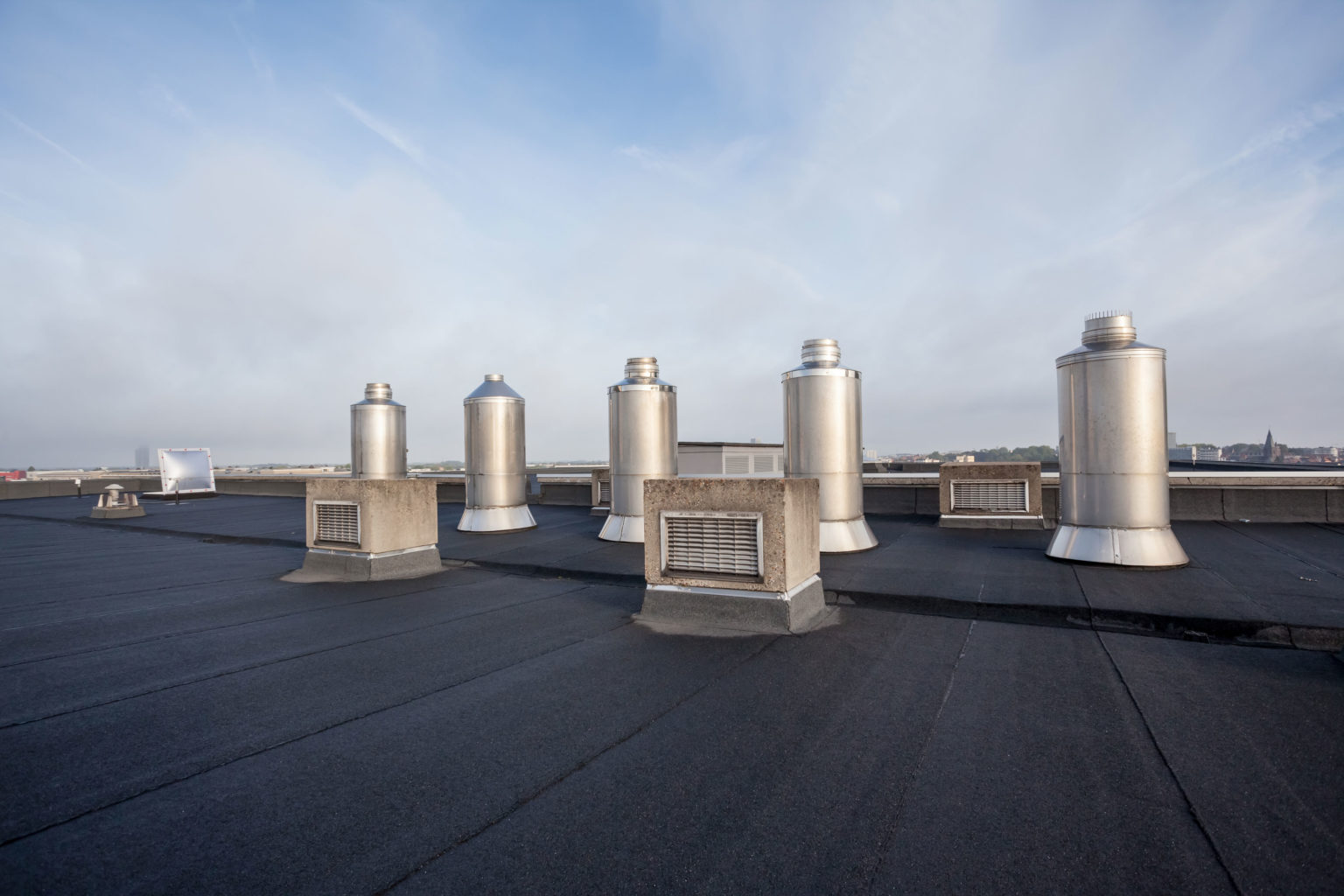Will you know when it’s time to replace your commercial roof?
How do you know when it’s time to replace your commercial roof? Since your building is often your most valuable asset, it’s critical to preserve it.
A commercial roof’s primary function is to protect the contents of your building from leaks. Unfortunately, many weaknesses may work together to compromise your commercial roof’s ability to drain as it was designed.
Water moves by gravity, and it’s always looking for the path of least resistance to find its way to the ground below. In a perfect scenario, rainwater or melting snow and ice will flow to the roof’s drainage system and be carried safely to the ground.
It isn’t easy to know exactly when to begin considering a complete replacement of your commercial building’s roof. In this blog, we’ll help you determine when to start planning for a new roof by giving you seven signs that the time may be near.
Sign #1: Your Roof is Getting Old
A commercial roof’s lifespan is typically 20-30 years, depending on the type of construction and materials used. This is usually a good benchmark for estimating the life expectancy of your roof. Well-maintained roofs tend to have a longer life expectancy, while poorly maintained roofs typically have shorter lives.
Sign #2: Pooled Water and Low Spots
Low areas on your roof might indicate that your roof’s insulation is compressed or that there are other issues that need addressing. If you don’t address low spots right away, they’ll only get worse rather than better. Immediately after it rains is the ideal time to look for low places by looking for pooled water.
If you notice any pooling or puddles, the first thing to do is make sure all drains are open. If they’re clear, consider hiring a commercial roofing contractor. They will assess the roof’s structure for integrity concerns, provide a detailed report, and recommend the necessary repairs or replacement.
Sign #3: Blistering or Bubbling
Bubbling, also known as roof blistering, is a common problem with membrane roofs such as built-up roofing, TPO, PVC, and EPDM.
If there is a leak between layers, a bubble forms beneath the membrane. This problem is usually caused by moisture or wind entering beneath the membrane, though it can also be due to poor installation or ventilation problems. It’s worth noting that areas with significant seasonal temperature swings are more likely to experience this problem. Minnesota experiences the most extensive range of climates, from its frigid winters to hot summers.
Small blisters, if left untreated, can cause extensive damage to your roof. If you notice blisters or bubbles forming on your roof, get an expert roofer to inspect and repair it right away. You may be able to catch the problem before it becomes severe enough to necessitate a replacement.
Sign #4: Visible Storm Damage
Unfortunately, your business’s roof is not storm-resistant. Hail, sleet, and snow can all wreak havoc on your roof. Not only is your roof vulnerable to the elements, but high winds may also blow debris onto it.
Regular maintenance and inspections are your best lines of defense for your roof. By staying proactive, you can take control of your commercial roof’s lifespan and ensure its longevity.
PRO TIP: Always have your roof professionally checked after a hailstorm. Hail can cause significant damage to your roof, including punctures and cracks, which may not be immediately visible. A professional inspection can help identify and address these issues before they worsen.
Sign #5: Damaged Flashing or Pitch Pans
Flashing diverts water away from places where the roof meets a vertical surface, such as chimneys, dormers, and skylights. Along with Pitch Pans, they’re the first line of defense against water getting into your building.
Pitch Pans are metal sleeves that surround any protrusion on your roof.
Pitch pans and flashing that become damaged may not be able to remove the water away from the protrusion, allowing water to seep into your building. These leaks generally start slowly and might be tricky to spot at first. As a result, maintaining a routine roof inspection schedule is critical for the long-term integrity of your commercial roof.
Sign #6: Roof Membrane Holes or Tears
This one seems obvious, but many commercial roof membrane holes are hidden from plain view. You’ll find vital equipment on many commercial roofs, such as HVAC and generator systems. Hospitals and factories may have additional appliances mounted to the roof to serve their specific operational requirements. Maintaining this specialized equipment regularly is a must. There’s always the chance that your roofing membrane will get damaged or pierced during installation and maintenance.
Sign #7: Wind Damage
Wind gusts, sustained periods of high wind, and straight-line winds can all cause damage to the roof of your commercial building. It’s easy to forget that your roof needs to be inspected after wind episodes because there is often no rainfall involved.
While membrane systems are generally not prone to blow-offs, if the seams are not properly sealed, they may separate and fly loose. This can be a significant problem in areas that experience frequent strong winds or taller commercial buildings. The more often your structure is exposed to severe winds, the more likely a commercial roof replacement will be required sooner.
Many facility managers are under the impression that a seam will fail, but it’s more likely that the system will fail where it connects to the flashing. When winds reach a particular strength, they can cause extreme negative pressure in large buildings such as schools and shopping malls.
Be sure to familiarize yourself with what your commercial insurance covers. Wind damage is often covered and can help with the replacement cost.
Prevention is the best medicine for a healthy commercial roof.
The common denominator in these seven signs that it’s time to replace your commercial roof is that frequent professional inspection is often the only way to tell if your roof is in trouble. Our Mint Roofing inspectors are not just trained, but highly skilled to spot hidden issues that laypeople tend to overlook, giving you peace of mind about the thoroughness of the process.
If you’re not a subscriber to our TopSite Preventative Maintenance Program, we encourage you to have us come out to inspect your roof after any of the situations we’ve discussed in this blog. By detecting issues early, we can help you get the longest possible life from your commercial roof and save you money in the process, motivating you to take action.
Give us a call at (952) 473-8080 or email us today, and let’s ensure your roof is in tip-top condition today and all year round!
FAQs
Q: How can I tell if my commercial roof needs to be replaced?
A: Look for signs such as water leaks, visible damage like cracks or holes, excessive wear and tear, recurring roof repairs, increased energy bills, and an aging roof beyond its expected lifespan. If you notice any of these signs, it’s time to consider a roof replacement.
Q: What is the average lifespan of a commercial roof?
A: The lifespan of a commercial roof can vary depending on various factors, including the type of roofing material used. However, on average, most commercial roofs last between 20 to 30 years. Regular maintenance and prompt repairs can help extend the lifespan of your roof.
Q: Can I simply repair my commercial roof instead of replacing it?
A: In some cases, minor repairs can address specific issues with a commercial roof. However, if your roof is showing multiple signs of damage or has exceeded its expected lifespan, a complete roof replacement may be more cost-effective and provide long-term benefits in terms of durability and energy efficiency.
Q: How long does it take to replace a commercial roof?
A: The duration of a commercial roof replacement can vary depending on factors such as the roof’s size, the project’s complexity, and weather conditions. Generally, a roof replacement can take anywhere from a few days to a few weeks. A professional roofing contractor can provide a more accurate estimate based on your situation.
Q: What are the benefits of replacing my commercial roof?
A: Replacing your commercial roof offers several benefits. It enhances the overall structural integrity of the building, reduces the risk of water leaks and associated damage, improves energy efficiency, and provides better insulation. A new roof can also enhance the aesthetic appeal of your property and increase its value.



